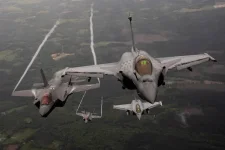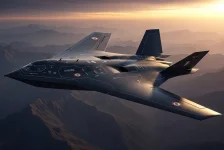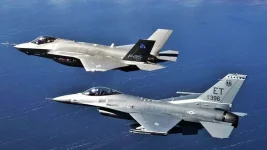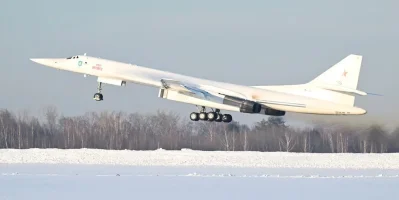- Views: 10K
- Replies: 67

India's ongoing efforts to modernize its Air Force (IAF) have brought two advanced fighter jets into focus: the Lockheed Martin F-35 Lightning II and the Dassault Rafale F4.
A detailed cost analysis, considering both acquisition and 40-year life cycle costs (LCC), reveals a significant financial disparity between the two platforms if India were to procure 110 units of either aircraft.
Life cycle costs provide a holistic view of the long-term financial implications, encompassing not only the initial purchase but also operating, maintenance, and support expenses throughout the aircraft's operational life.
The F-35, a fifth-generation stealth fighter, is produced in three variants: the F-35A (conventional takeoff and landing), F-35B (short takeoff and vertical landing), and F-35C (carrier-based). For the IAF's needs, the F-35A is the most suitable due to its compatibility with land-based operations and its lower price point compared to the other variants.
As of 2023, increased production and economies of scale have driven down the F-35A's unit cost. Lockheed Martin and US government data indicate a flyaway cost of approximately $82.5 million per unit. However, international sales typically involve added expenses for training, spare parts, and support equipment, raising the effective unit cost to an estimated $100-110 million.
For this analysis, an export price of $110 million per unit is assumed. This places the total acquisition cost for 110 F-35As at roughly $12.1 billion. This figure includes initial spares, training, and basic support infrastructure, but excludes weapons packages, which would represent a further cost dependent on Indian requirements.
The Rafale F4, an advanced 4.5-generation multi-role fighter, is already in service with the IAF, with 36 units procured under a 2016 agreement. The F4 variant represents an upgrade over the previous F3R standard, featuring enhanced radar capabilities, improved sensors, and advanced network-centric warfare capabilities.
The cost of the Rafale has been variable, contingent on specific contract terms and customization. India's initial purchase of 36 Rafales totaled €7.87 billion (approximately $8.7 billion at 2016 exchange rates), which equates to around $242 million per unit. This price included India-specific enhancements, weapons, spares, and infrastructure.
However, subsequent contracts with other nations, such as Egypt and Indonesia, point to a lower flyaway cost of $115-130 million per unit for the base aircraft, with additional costs for customizations and support. For this comparison, a unit cost of $130 million for the F4 variant is used, representing a standardized export price without extensive India-specific modifications.
At $130 million per unit, the total acquisition cost for 110 Rafale F4s would be approximately $14.3 billion. This estimate accounts for basic spares and training, but excludes weapons and additional infrastructure, the costs of which would depend on the IAF's specific needs.
40-Year Life Cycle Cost (LCC) Comparison
To estimate the total financial commitment, a 40-year service life, consistent with modern fighter jet lifespans, is assumed. The LCC includes acquisition, operation, maintenance, personnel, upgrades, and spares.The F-35 is recognized for its high operating and maintenance costs, largely due to its stealth features, sophisticated electronics, and complex logistics. Data from the US Government Accountability Office (GAO) and other sources can be adapted to create an India-specific estimate.
The F-35A's operating cost is approximately $33,000 per flight hour (as of 2023), although Lockheed Martin has stated a goal to reduce this to $25,000 by 2025. A conservative average of $30,000 per flight hour is used for this 40-year projection.
Assuming each F-35 flies 250 hours annually (a standard estimate for fighter aircraft), the annual operating cost per aircraft is $7.5 million. Over 40 years, this amounts to $300 million per aircraft, and $33 billion for a fleet of 110.
Maintenance costs for the F-35 are substantial, driven by its stealth coatings, advanced sensors, and software updates. Estimates suggest maintenance accounts for 60-70% of operating costs. Assuming 65% of the operating cost ($19,500 per flight hour), the total maintenance cost over 40 years is approximately $21.45 billion for 110 units.
Over a 40-year period, periodic upgrades (including software, avionics, and stealth enhancements) and spares could add 20-30% to the LCC. Assuming 25% of the combined operating and maintenance costs, an additional $13.61 billion is projected.
Therefore, the total LCC for 110 F-35As is estimated as follows:
- Acquisition: $12.1 billion
- Operating: $33 billion
- Maintenance: $21.45 billion
- Upgrades and Spares: $13.61 billion
- Total: $80.16 billion
The Rafale's operating cost is approximately $16,500 per flight hour, significantly lower than the F-35 due to simpler maintenance and the absence of stealth-related upkeep. Assuming 250 flight hours per year, the annual operating cost per Rafale is $4.125 million.
Over 40 years, this amounts to $165 million per aircraft, and $18.15 billion for a fleet of 110.
Maintenance costs for the Rafale are estimated at 50-60% of operating costs due to its robust design and lower complexity. Assuming 55% ($9,075 per flight hour), the total maintenance cost over 40 years is approximately $9.98 billion for 110 units.
Upgrades and spares for the Rafale, including radar enhancements and weapon integration, are estimated at 20-25% of combined operating and maintenance costs. Assuming 22.5%, an additional $6.28 billion is projected.
Therefore, the total LCC for 110 Rafale F4s is estimated as follows:
- Acquisition: $14.3 billion
- Operating: $18.15 billion
- Maintenance: $9.98 billion
- Upgrades and Spares: $6.28 billion
- Total: $48.71 billion
Comparative Summary and Implications
While the initial acquisition cost for 110 Rafale F4s ($14.3 billion) is $2.2 billion higher than that of 110 F-35As ($12.1 billion), the long-term financial picture significantly favors the Rafale. The F-35's 40-year LCC is $31.45 billion higher than the Rafale F4, representing a 64.6% increase.This substantial difference is primarily attributed to the F-35's significantly higher operating and maintenance costs, stemming from its stealth technology, complex electronics, and logistical demands.
The Rafale F4 presents a more cost-effective option over the long term, offering substantial savings that could potentially be allocated to indigenous programs or other defense priorities. However, the F-35's fifth-generation capabilities, including stealth and advanced sensor fusion, offer a strategic advantage that the Rafale cannot match.
The IAF's ultimate decision will likely involve a careful balancing of strategic requirements, budgetary constraints, and long-term goals for self-reliance. The Rafale F4, with its lower LCC and existing operational integration within the IAF, may be favored for its cost-effectiveness.




